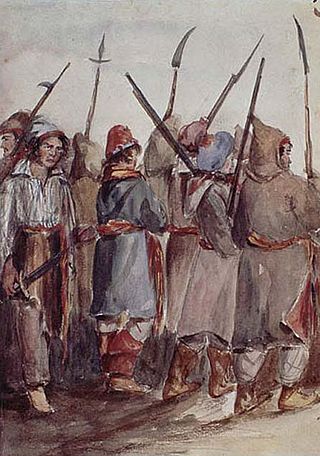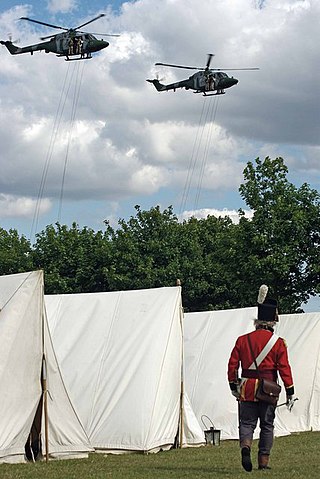Related Research Articles

Guerrilla warfare is a form of unconventional warfare in which small groups of irregular military, such as rebels, partisans, paramilitary personnel or armed civilians including recruited children, use ambushes, sabotage, terrorism, raids, petty warfare or hit-and-run tactics in a rebellion, in a violent conflict, in a war or in a civil war to fight against regular military, police or rival insurgent forces.

Urban warfare is warfare in urban areas such as towns and cities. Urban combat differs from combat in the open at both the operational and the tactical levels. Complicating factors in urban warfare include the presence of civilians and the complexity of the urban terrain. Urban combat operations may be conducted to capitalize on strategic or tactical advantages associated with the possession or the control of a particular urban area or to deny these advantages to the enemy.

Unconventional warfare (UW) is broadly defined as "military and quasi-military operations other than conventional warfare" and may use covert forces, subversion, or guerrilla warfare. This is typically done to avoid escalation into conventional warfare as well as international conventions.

Close-quarters combat (CQC) or close-quarters battle (CQB) is a close combat situation between multiple combatants involving ranged or melee combat. It can occur between military units, law enforcement and criminal elements, and in other similar situations.

An insurgency is a violent, armed rebellion by small, lightly armed bands who practice guerrilla warfare from primarily rural base areas against a larger authority. The key descriptive feature of insurgency is its asymmetric nature: small irregular forces face a large, well-equipped, regular military force state adversary. Due to this asymmetry, insurgents avoid large-scale direct battles, opting instead to blend in with the civilian population where they gradually expand territorial control and military forces. Insurgency frequently hinges on control of and collaboration with local populations.

Jungle warfare or woodland warfare is warfare in forests, jungles, or similar environments. The term encompasses military operations affected by the terrain, climate, vegetation, and wildlife of densely-wooded areas, as well as the strategies and tactics used by military forces in these situations and environments.

The Second Battle of Fallujah, initially codenamed Operation Phantom Fury,Operation al-Fajr was an American-led offensive of the Iraq War that lasted roughly six weeks, starting 7 November 2004. Marking the highest point of the conflict against the Iraqi insurgency, it was a joint military effort carried out by the United States, the Iraqi Interim Government, and the United Kingdom. Within the city of Fallujah, the coalition was led by the U.S. Marine Corps and U.S. Army, the battle was later described as "some of the heaviest urban combat U.S. military have been involved in since the Battle of Huế City in Vietnam in 1968".
Fourth-generation warfare (4GW) is conflict characterized by a blurring of the distinction between war and politics, and of the distinction between combatants and civilians.

Military advisors or combat advisors are military personnel deployed to advise on military matters. The term is often used for soldiers sent to foreign countries to aid such countries' militaries with their military education and training, organization, and other various military tasks. The foreign powers or organizations may send such soldiers to support countries or insurgencies while minimizing the risks of potential casualties and avoiding the political ramifications of overtly mobilizing military forces to aid an ally.

Irregular military is any non-standard military component that is distinct from a country's national armed forces. Being defined by exclusion, there is significant variance in what comes under the term. It can refer to the type of military organization, or to the type of tactics used. An irregular military organization is one which is not part of the regular army organization. Without standard military unit organization, various more general names are often used; such organizations may be called a troop, group, unit, column, band, or force. Irregulars are soldiers or warriors that are members of these organizations, or are members of special military units that employ irregular military tactics. This also applies to irregular infantry and irregular cavalry units.

Modern warfare is warfare that diverges notably from previous military concepts, methods, and technology, emphasizing how combatants must modernize to preserve their battle worthiness. As such, it is an evolving subject, seen differently in different times and places. In its narrowest sense, it is merely a synonym for contemporary warfare.

Counterinsurgency is "the totality of actions aimed at defeating irregular forces". The Oxford English Dictionary defines counterinsurgency as any "military or political action taken against the activities of guerrillas or revolutionaries" and can be considered war by a state against a non-state adversary. Insurgency and counterinsurgency campaigns have been waged since ancient history. However, modern thinking on counterinsurgency was developed during decolonization. Within the military sciences, counterinsurgency is one of the main operational approaches of irregular warfare.

Francis J. "Bing" West Jr. is an American author, Marine combat veteran and former Assistant Secretary of Defense for International Security Affairs during the Reagan Administration.

The Counter-Insurgency and Jungle Warfare School (CIJWS) in Vairengte, Mizoram, India is a training and research establishment of the Indian Army specialising in unconventional warfare, especially counter-insurgency and guerrilla warfare. CIJWS is one of the premier counter-insurgency training institutions in the world. The school's motto is to "fight the guerrilla like a guerrilla".

The Battle of Tal Afar also known as Operation Restoring Rights was a military offensive conducted by the United States Army and supported by Iraqi forces, to eliminate Al Qaeda in Iraq and other insurgents in the city of Tal Afar, Iraq in response to the increase of insurgent attacks against U.S. and Iraqi positions in the area and to end the brutal tactics against the population by the terrorists. Coalition Forces consisted of 3rd Armored Cavalry Regiment, elements of the 82nd Airborne Division, and two brigades of the Iraqi 3rd Division, all were under the command of Col. H.R. McMaster. AQI had used the city as a staging ground for moving foreign fighters into Iraq since early 2005. The city was temporarily cleared for elections in 2005, but was not secured in a long-term view.

Foreign internal defense (FID) is a term used by the military in several countries, including the United States, France, and the United Kingdom, to describe an integrated, or multi-country approach to combating actual or threatened insurgency in a foreign state. This foreign state is known as the Host Nation (HN) under the US doctrine. The term counter-insurgency is commonly used for FID.

The Flechas were an elite paramilitary tactical unit of the Portuguese secret police that operated in Angola and Mozambique during the Portuguese Colonial War. Unlike most of the other Portuguese special forces that were employed in the several theatres of operations of the conflict, the Flechas were not a de jure military unit but a PIDE/DGS unit.

The U.S. Army Special Forces traces its roots as the Army's premier proponent of unconventional warfare from purpose-formed special operations units like the Alamo Scouts, Philippine guerrillas, First Special Service Force, and the Operational Groups (OGs) of the Office of Strategic Services. Although the OSS was not an Army organization, many Army personnel were assigned to the OSS and later used their experiences to influence the forming of Special Forces.

The 4th Marine Expeditionary Brigade was a Marine expeditionary brigade of the United States Marine Corps that was designed specifically for counterterrorism. Its mission was to be able to quickly deploy anywhere in the world to combat terrorism and deter, detect, and defend from terrorist groups both domestically and internationally. The unit became operational on 29 October 2001, and was deactivated in February 2006.

In military history, the term "generations of warfare" refers to the concept of five "generations" in warfare, with each generation having different tactics, strategies, and technologies. The generations of warfare are sometimes dubbed as "4GW" or "5GW". The term originated in 1989 to describe "the changing face of war" over time, initially only referring to the emergence of the fourth generation, but eventually seeing the addition of a fifth generation.
References
- ↑ "Dehner, Paul A., "Size Matters: Turning to Small Teams to Succeed at Counterinsurgency", Australian Army Journal, Vol. VII, No. 3, pp. 35-45" (PDF). Archived from the original (PDF) on 2018-10-14. Retrieved 2017-07-01.
- ↑ Gardiner, James E.. "Book Review: DRAGON DAYS: Time for 'Unconventional' Tactics" Archived 2011-10-29 at the Wayback Machine , Leatherneck
- ↑ William S. Lind, "Post-Machine Gun Tactics", 18 November 2003, military.com
- ↑ "Hord, J. Mark. "Stratiotes' Military History Book Reviews", Unconventional Warfare Review, 31 January 2007". Archived from the original on 25 April 2012. Retrieved 23 October 2011.